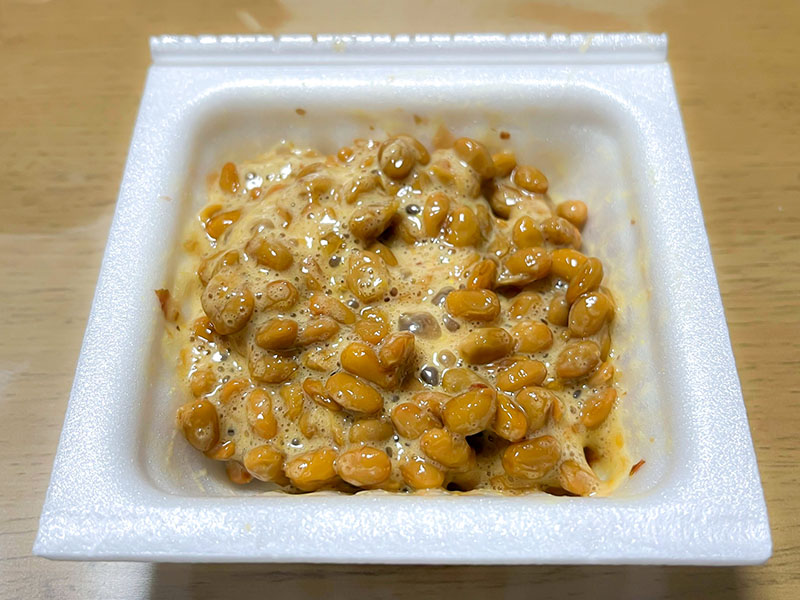Natto is a typical fermented food that is considered to be good for your health.
However, did you know that the sauce and mustard that come with natto contain food additives that may be harmful to your health?
Yuji Watanabe says that natto itself is additive-free and safe because it is made from soybeans and natto bacillus only.
The problem is the additives in the accompanying sauce and mustard.
INDEX
Dangers of additives in natto sauce
The following additives are mainly used in natto sauce
- Seasonings (amino acids, etc.):
… used to add flavour. Excessive intake should be avoided. - Acidifiers:
… used to add acidity. Excessive intake is hard on the body. - Alcohol:
… used to increase shelf life.
These additives are not a major problem if used in small amounts, but should be used as sparingly as possible.
Amino acids, a type of chemical seasoning, in particular, can make it difficult for children to experience the natural flavour of the food if they continue to consume them from childhood.
Beware of colouring and thickening agents in mustard.
In some cases, the following additives are used in mustard
- Colouring agents such as turmeric dye:
… used to make the colour of mustard appear brighter. - Polysaccharides thickeners such as carrageenan and tragacanth gum:
… used to give the mustard a smooth texture.
The colouring agent turmeric dye is relatively safe, but should not be consumed in large quantities.
On the other hand, some thickened polysaccharides, such as carrageenan and tragacanth gum, have been shown to have adverse effects on the body in animal experiments, so care should be taken.
Tips for eating natto safely.

So how can you eat natto without worrying about additives?
The following points should be kept in mind. 1.
- choose natto that does not come with any sauce or additives
- do not use the accompanying sauce and mustard, but season with soy sauce, Japanese mustard, wasabi, etc.
- choose natto made from 100% domestic soybeans and with no additives
- add seaweed or egg yolk to natto to increase its flavour and nutritional value
- add grated radish to natto for a spicy and refreshing taste
- combining natto with tomatoes increases the absorption rate of lycopene
By adopting these innovations, you can enjoy safe and nutritious natto.
Checklist of food additive dangers
A great variety of additives are used in the foods we eat.
The following is a list of additives of which we should be particularly careful.
Top 10 additives to be wary of! Top 10 additives to avoid.
- sodium benzoate (preservative)
- Often used in soft drinks and nutritional drinks, and is feared to have adverse effects on gastrointestinal mucosa. 2. 2, Sodium sulfite (bleaching agent and preservative)
- Used in dried fruit and wine. Irritation of the gastrointestinal tract has been noted. 3, Sodium hypochlorite (disinfectant).
- Used to sterilise vegetables, but residues in foodstuffs are a problem. 4. 4 Propylene glycol (moisturiser)
- Widely used in processed foods and cosmetics, but there are concerns about the burden on the liver and kidneys if large amounts are ingested.
- tar dye (colouring agent)
- Artificial colouring suspected to be carcinogenic. Used in chocolate, candy, etc. 6 Synthetic sweeteners (aspartame, sucralose, etc.)
- Used in diet drinks, etc., but safety is questionable. 7 Sodium nitrite (colouring agent)
- Used in ham, sausages, etc., but may turn into a carcinogen. 8 BHA and BHT (antioxidants)
- Used in processed foods and cosmetics, but have been identified as carcinogenic.
- aluminium-containing food additives (e.g. antioxidants)
- Used in white chocolate and cheese. Fear of health hazards due to excessive intake of aluminium.
- glycyrrhizic acid (sweetener)
- Naturally occurring sweetener found in liquorice and other plants, but may cause pseudo-aldosteronism in large doses.
Relatively safe additives
On the other hand, the following additives are relatively safe.
- Vitamin C and vitamin E (antioxidants)
- Pectin/xanthan gum (thickening and stabilising agents)
- Ca carbonate and Mg carbonate (pH regulators)
- Sucrose fatty acid esters and glycerol fatty acid esters (emulsifiers)
However, ‘safe’ does not equal ‘safe to consume in large quantities’.
It is still wise to keep food additives to a minimum.
Deal with food additives wisely
Food additives are an essential part of our diet, but some should be avoided.
It is of course important to choose foods without additives, but it is also true that it is difficult to avoid them altogether.
It is therefore important to know the characteristics of additives and to get along well with them.
For example, the amino acids introduced in this article can be used in minimal amounts to reduce their effect on the sense of taste.
It is also important to demand that food manufacturers use safer additives that are labelled in bulk names.
If consumer awareness changes, safer and tastier food will spread.
Conclusion.
Natto is a healthy food, but the additives in the accompanying sauce and mustard must be carefully monitored.
It is recommended to season it with the simplest possible seasoning and eat it well.
Furthermore, it is important to know the characteristics of food additives and to get along well with them.
By becoming a wise consumer, each and every one of us can realise a safer and tastier diet.
Let’s make the most of the power of natto and live a healthy life!
Have a good life!




Comment